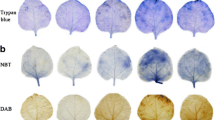Abstract
Bougainvillea xbuttiana antiviral proteins (AVPs) exhibited high antioxidant activity as measured by ferric reducing / antioxidant (FRAP) power assay. These AVPs were also found to modify activities of antioxidant enzymes like superoxide dismutase, peroxidase and catalase. The activities of superoxide dismutase and peroxidase increased, while the activity of catalase decreased in Tobacco mosaic virus (TMV) infected tobacco leaves. The trend was reversed when the leaves were treated with AVP alone. However, in TMV + AVP treated leaves, the activities of all the three enzymes were found to be midway between the activities obtained with other two treatments. It is therefore, suggested that Bougainvillea AVPs might be controlling viral diseases by scavenging reactive oxygen species as well as by altering host plant cell metabolism to maintain its antioxidant status.
Similar content being viewed by others
Abbreviations
- AVPs:
-
antiviral proteins
- CAT:
-
catalase
- FRAP:
-
ferric reducing/antioxidant power
- HR:
-
hypersensitive response
- POD:
-
peroxidase
- ROS:
-
reactive oxygen species
- SA:
-
salicylic acid
- SAR:
-
systemic acquired resistance
- SOD:
-
superoxide dismutase
- SRV:
-
sunnhemp rosette virus
- TMV:
-
tobacco mosaic virus.
References
Verma H N, Varsha & Baranwal V K, In Antiviral proteins in higher plants. (M Chessin, D DeBorde, A Zipf, Editors). CRC Press, Boca Raton, Florida (1995) pp 23–37.
Varma A, In Crop protection and sustainable agriculture. Wiley Chichester, Ciba Foundation Symposium 177, (1993) pp 40–157.
Mittler R, Trends Plant Sci, 7 (2002) 405.
Greenberg J T, Guo A L, Klessig D F & Ausubel FM, Cell, 77 (1994) 551.
Bowler C, Slooten L, Vandenbranden S, DeRycke R, Botterman J, Sybesma C, Van Montagu M & Inze D, EMBO, 10 (1991) 1723.
Klesig DF & Malamy J, Plant Mol Biol, 26 (1994) 1439.
Narwal Sneh, Balasubrahmanyam A, Lodha ML & Kapoor HC, Indian J Biochem Biophys, 38 (2001) 342.
Benzie IFF & Strain JJ, Methods Enzymol, 209 (1999) 15.
Beauchamp CH & Fridovich I, Anal Biochem, 44 (1971) 276.
Zeislin N & Zaken RB, Plant Growth Regulation, 11 (1992) 53.
Teranishi Y, Tanaka A, Osumi M & Fukui S, Agril and Biochem, 38 (1974) 1213.
Yalpani N, Silverman P, Wilson TMA, Kleier DA & Raskin I, Plant Cell, 3 (1991) 809.
Narwal Sneh, Balasubrahmanyam A, Sadhna P, Kapoor HC & Lodha ML, Indian J Expt Biol, 39 (2001) 600.
Gholizadeh A, Kumar M, Balasubrahmanyam A, Sharma S, Narwal S, Lodha ML & Kapoor HC, J Plant Biochem Biotechnol, 13 (2004) 13.
Karel M, Tannenhaum SR, Wallace DH & Maloney H, J Food Sci, 31 (1996) 892.
Ebel J & Casio EG, Int Rev Cytol, 148 (1994) 1.
Smirnoff N, Ann Bot, 78 (1996) 661.
Chen ZX, Silva H & Klesig DF, Science, 262 (1993) 1883.
Adam AL, Bestwick CS, Barna B & Mansfield JW, Planta, 191 (1995) 240.
Apostol I, Heinstein PF & Low PS, Plant Physiol, 90 (1989) 109.
Legrand M, Fritig B & Hirth L, Phytochemistry, 15 (1976) 1353.
Neuenschwander V, Vernoolj B, Friedrich L, Uknes S, Kessmann H & Ryals J, Plant J, 8 (1995) 227.
Clarke SE, Guy PL, Burritt DJ & Jameson PE, Physiol. Plant, 114 (2002) 157.
Desikan R, Reynolds A, Hancock J & Neil S, Biochem J, 330 (1998) 115.
Ward ER, Uknes SJ, Williams SC, Dincher SS, Wiederhold DL, Alexander DC, Ahl-Goy P, Metraux JP & Ryals JA, Plant Cell, 3 (1991) 1085.
Heil M & Bostock RM, Ann Bot, 89 (2002) 503.
Author information
Authors and Affiliations
Corresponding author
Additional information
Part of Ph.D. thesis submitted to Post-Graduate School, IARI, New Delhi
Rights and permissions
About this article
Cite this article
Bhatia, S., Kapoor, H.C. & Lodha, M.L. Modification of Antioxidant Status of Host Cell in Response to Bougainvillea Antiviral Proteins. J. Plant Biochem. Biotechnol. 13, 113–118 (2004). https://doi.org/10.1007/BF03263204
Received:
Accepted:
Published:
Issue Date:
DOI: https://doi.org/10.1007/BF03263204




